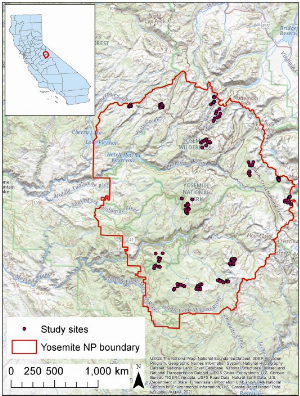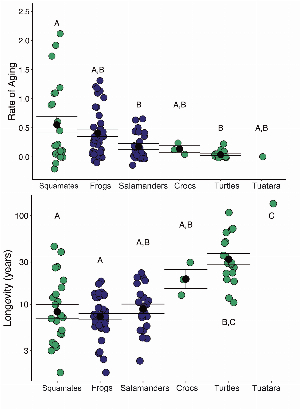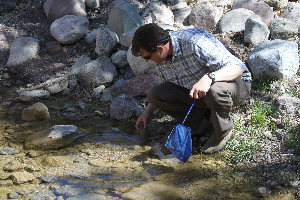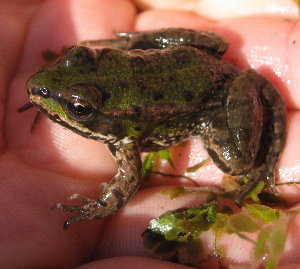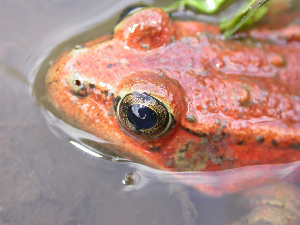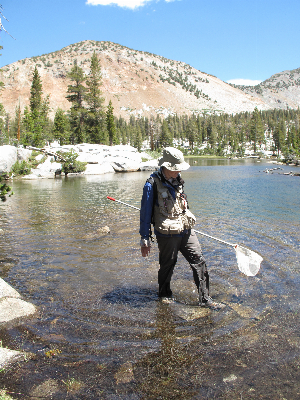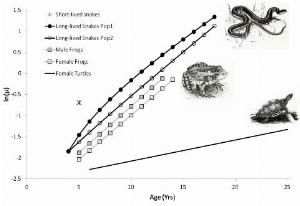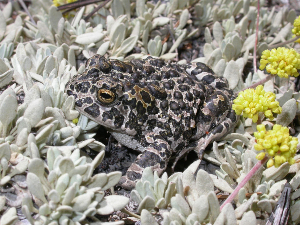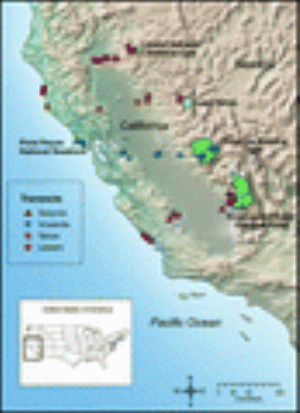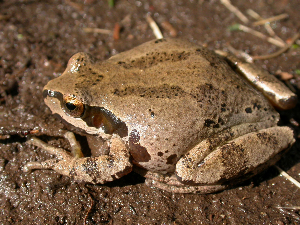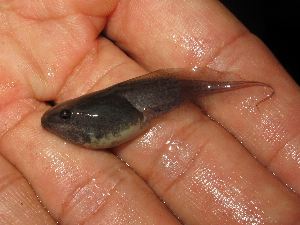Search ARMI Database
Search term(s)
Contribution Number
Search Results
59 record(s) found.
Papers & Reports Sierra Nevada amphibians demonstrate stable occupancy despite precipitation volatility in the early 21st Century
Authors: Brian J Halstead; Patrick M Kleeman; Jonathan P Rose; Gary M Fellers
Date: 2023-02-07 | Outlet: Frontiers in Ecology and Evolution
Climate can have a strong influence on species distributions, and amphibians with different life histories might be affected by annual variability in precipitation in different ways. The Sierra Nevada of California, United States, experienced some of the driest and wettest years on record in the early 21st Century, with variability in annual precipitation predicted to increase with climate change. We examined the relationship between adult occupancy dynamics of three high elevation anurans and site and annual variation in measures of winter severity, summer wetness, and cumulative drought. We further evaluated how these weather conditions affected the probability that each species would reproduce, conditional on their occurrence at a site. We found that although different aspects of weather affected the occupancy dynamics of each species differently, adult occupancy probabilities were generally stable throughout our 15-year study period. The probability of reproduction, although slightly more variable than adult occupancy, was similarly stable throughout the study. Although occurrence of the three species was resilient to recent extremes in precipitation, more detailed demographic study would inform the extent to which amphibian populations will remain resilient to increasing severity, duration, and frequency of drought and flood cycles.
Papers & Reports Diverse aging rates in ectotherms provide insights for the evolution of aging and longevity
Authors: Beth A Reinke; Hugo Cayuela; Fredric J Janzen; Jean-Francois Lemaitre; Jean-Michel Gaillard; Michelle A Lawing; John B Iverson; Ditte G Christiansen; Iñigo Martinez-Solano; Gregorio Sánchez-Montes; Jorge Gutiérrez-Rodríguez; Francis L Rose; Nicola Nelson; Susan Keall; Alain J Crivelli; Theodoros Nazirides; Annegret Grimm-Seyfarth; Klaus Henle; Emiliano Mori; Gaëtan Guiller; Rebecca Homan; Anthony Olivier; Erin Muths; Blake R Hossack; Xavier Bonnet; David S Pilliod; Marieke Lettink; Tony Whitaker; Benedikt R Schmidt; Michael G Gardner; Marc Cheylan; Francoise Poitevin; Ana Golubovi?; Ljiljana Tomovic; Dragan Arsovski; Richard A Griffiths; Jan W Arntzen; Jean-Pierre Baron; Jean-Francois Le Galliard; Thomas Tully; Luca Luiselli; Massimo Capula; Lorenzo Rugiero; Rebecca M McCaffery; Lisa A Eby; Venetia Briggs-Gonzalez; Frank J Mazzotti; David Pearson; Brad A Lambert; D M Green; Nathalie Jreidini; Claudio Angelini; Graham Pyke; Jean-Marc Thirion; Pierre Joly; Jean-Paul Lena; Tony Tucker; Col Limpus; Pauline Priol; Aurélien Besnard; Pauline Bernard; Kristin Stanford; Richard King; Justin Garwood; Jaime Bosch; Franco Souza; Jaime Bertoluci; Shirley Famelli; Kurt Grossenbacher; Omar Lenzi; Kathleen Matthews; Sylvain Boitaud; Deanna H Olson; Tim Jessop; Graeme Gillespie; Jean Clobert; Murielle Richard; Andrés Valenzuela-Sánchez; Gary M Fellers; Patrick M Kleeman; Brian J Halstead; Evan HC Grant; Phillip G Byrne; Thierry Frétey; Bernard Le Garff; Pauline Levionnois; John C Maerz; Julian Pichenot; Kurtulus Olgun; Nazan Uzum; Aziz Avci; Claude Miaud; Johan Elmberg; Gregory P Brown; Richard Shine; Nathan F Bendik; Lisa O'Donnell; Courtney L Davis; Michael J Lannoo; Rochelle M Stiles; Robert M Cox; Aaron M Reedy; Daniel A Warner; Eric Bonnaire; Kristine Grayson; Roberto Ramos-Targarona; Eyup Baskale; David J Muñoz; John Measey; Andre de Villiers; Will Selman; Anne M Bronikowski; David AW Miller
Date: 2022-06-23 | Outlet: Science
Comparative studies of mortality in the wild are necessary to understand the evolution of aging, yet ectothermic tetrapods are under-represented in this comparative landscape despite their suitability for testing evolutionary hypotheses. We provide the first comprehensive study of aging rates and longevity across tetrapod ectotherms in the wild, utilizing data from 107 populations (77 species) of reptiles and amphibians. We test hypotheses of how thermoregulatory mode, temperature, protective phenotypes, and pace of life contribute to aging. Controlling for phylogeny and body size, ectotherms displayed a higher diversity of aging rates than endotherms, and included many groups with negligible aging. Furthermore, protective phenotypes and life-history tactics further explained macroevolutionary patterns of aging. By including ectothermic tetrapods, our comparative analyses enhance our understanding of aging evolution.
Papers & Reports Quantifying climate sensitivity and climate driven change in North American amphibian communities
Authors: David AW Miller; Evan HC Grant; Erin Muths; Staci M Amburgey; Michael J Adams; M B Joseph; Hardin J Waddle; P TJ Johnson; Maureen E Ryan; Benedikt R Schmidt; Daniel L Calhoun; Courtney L Davis; Robert N Fisher; David E Green; Blake R Hossack; Tracy A. Rittenhouse; Susan C Walls; Larissa L Bailey; Sam S Cruickshank; Gary M Fellers; Thomas A Gorman; C A Haas; Ward Hughson; David S Pilliod; S J Price; Andrew M Ray; Walt J Sadinski; D Saenz; William J Barichivich; Adrianne B Brand; Cheryl S Brehme; Rosi G Dagit; Katy S Delaney; Brad M Glorioso; Lee B Kats; Patrick M Kleeman; Christopher A Pearl; Carlton J Rochester; Seth PD Riley; Mark F Roth; Brent H Sigafus
Date: 2018-08 | Outlet: Nature Communications
We quantified the response of amphibian communities to climatic variability across the United States and Canada using more than 500,000 observations for 81 species across 86 study areas. We estimated the relationships between annual variation in climate variables and local colonization and persistence probabilities across more than 5000 surveyed sites. This allowed us to estimate sensitivity to change in five climate variables. Climate sensitivity differs greatly among eco-regions and depends on local climate, species life-history, and phylogeny. Local species richness was especially sensitive to changes in water availability during breeding and changes in winter temperature. These results allowed us to ask whether changing climate explains strong overall rates of decline in species richness observed in our data set. We found that recent change in the climate variables we measured does not explain why North American amphibian richness is rapidly declining, but does explain why some populations decline faster than others. 
Papers & Reports Heterogeneous responses of temperate-zone amphibian populations to climate change complicates conservation planning
Authors: Erin Muths; Thierry C Chambert; Benedikt R Schmidt; David AW Miller; Blake R Hossack; Pierre Joly; O Grolet; David E Green; David S Pilliod; Marc Cheylan; Robert N Fisher; Rebecca M McCaffery; Michael J Adams; Wendy J Palen; Jan W Arntzen; Justin Garwood; Gary M Fellers; Jean-Marc Thirion; Aurélien Besnard; Evan HC Grant
Date: 2017-12 | Outlet: Scientific Reports. DOI:10.1038/s41598-017-17105-7
The pervasive and unabated nature of global amphibian declines suggests common demographic responses to a given driver, and quantification of major drivers and responses could inform broad-scale conservation actions. We explored the influence of climate on demographic parameters (i.e., changes in the probabilities of survival and recruitment) using 31 datasets from temperate zone amphibian populations (North America and Europe) with more than a decade of observations each. There was evidence for an influence of climate on population demographic rates, but the direction and magnitude of responses to climate drivers was highly variable among taxa and among populations within taxa. These results reveal that climate drivers interact with variation in life-history traits and population-specific attributes resulting in a diversity of responses. This heterogeneity complicates the identification of conservation ?rules of thumb? for these taxa, and supports the notion of local focus as the most effective approach to overcome global-scale conservation challenges.
Papers & Reports Population Trends, Survival, and Sampling Methodologies for a Population of Rana draytonii
Authors: Gary M Fellers; Patrick M Kleeman; David AW Miller; Brian J Halstead
Date: 2017-11-09 | Outlet: Journal of Herpetology 51:567-573
Estimating population trends provides valuable information for resource managers, but monitoring programs face trade-offs between the quality and quantity of information gained and the number of sites surveyed. We compared the effectiveness of monitoring techniques for estimating population trends of Rana draytonii at Point Reyes National Seashore, California, USA, over a 13-year period. Our primary goals were 1) to estimate trends for a focal pond at Point Reyes National Seashore, and 2) to evaluate whether egg mass counts could reliably estimate an index of abundance relative to more intensive capture-mark-recapture methods. Capture-mark-recapture surveys of males indicated a stable population from 2005 through 2009, despite low annual apparent survival (26.3%). Egg mass counts from 2000 through 2012 indicated that despite some large fluctuations, the breeding female population was generally stable or increasing, with annual abundance varying between 26 and 130 individuals. Minor modifications to egg mass counts, such as marking egg masses, can allow estimation of egg mass detection probabilities necessary to convert counts to abundance estimates, even when closure of egg mass abundance cannot be assumed within a breeding season. High egg mass detection probabilities (mean per-survey detection probability = https://0.98 [0.89-0.99]) indicate that egg mass surveys can be an efficient and reliable method for monitoring population trends of federally threatened R. draytonii. Combining egg mass surveys to estimate trends at many sites with capture-mark-recapture methods to evaluate factors affecting adult survival at focal populations is likely a profitable path forward to enhance understanding and conservation of R. draytonii.
Papers & Reports Large-scale recovery of an endangered amphibian despite ongoing exposure to multiple stressors
Authors: Roland A Knapp; Gary M Fellers; Patrick M Kleeman; David AW Miller; V T Vredenburg; Erica B Rosenblum; Cheryl J Briggs
Date: 2016-10-03 | Outlet: Proceedings of the National Academy of Sciences, doi: 10.1073/pnas.1600983113
Amphibians are one of the most threatened animal groups, with 32% of species at risk of extinction. Given this, is the disappearance of a large fraction of the Earth’s amphibians inevitable, or are some declining species more resilient than is generally assumed? We address this question in a species that is emblematic of many declining amphibians, the endangered Sierra Nevada yellow-legged frog (Rana sierrae). Based on >7,000 frog surveys conducted across Yosemite National Park over a 20-year period, we show that after decades of decline and despite ongoing exposure to multiple stressors including introduced fish, the recently emerged disease chytridiomycosis, and pesticides, R. sierrae abundance increased 7-fold during the study and at a rate of 11% per year. These increases occurred in hundreds of populations throughout Yosemite, providing a rare example of amphibian recovery at an ecologically relevant spatial scale. Results from a laboratory experiment indicate that these increases may be due in part to reduced frog susceptibility to chytridiomycosis. The disappearance of nonnative fish from numerous water bodies following cessation of stocking also contributed to the recovery. The large-scale increases in R. sierrae abundance we document suggest that when habitats are relatively intact and stressors are reduced in their importance by active management or species’ adaptive responses declines of some amphibian may be partially reversible, at least at a regional scale. Other studies conducted over similarly large temporal and spatial scales are critically needed to provide insight and generality about the reversibility of amphibian declines at a global scale.
Papers & Reports Quantitative evidence for the effects of multiple drivers on continental-scale amphibian declines
Authors: Evan HC Grant; David AW Miller; Benedikt R Schmidt; Michael J Adams; Staci M Amburgey; Thierry C Chambert; Sam S Cruickshank; Robert N Fisher; David E Green; Blake R Hossack; P TJ Johnson; M B Joseph; Tracy A. Rittenhouse; Maureen E Ryan; Hardin J Waddle; Susan C Walls; Larissa L Bailey; Gary M Fellers; Thomas A Gorman; Andrew M Ray; David S Pilliod; S J Price; D Saenz; Erin Muths
Date: 2016-05-23 | Outlet: Scientific Reports xx:xxx-xxx
Since amphibian declines were first proposed as a global phenomenon over a quarter century ago, the conservation community has made little progress in halting or reversing these trends. The early search for a "smoking gun" was replaced with the expectation that declines are caused by multiple drivers. While field observations and experiments have identified factors leading to increased local extinction risk, evidence for effects of these drivers is lacking at large spatial scales. Here, we use observations of 389 time-series of 83 species and complexes from 61 study areas across North America to test the effects of 4 of the major hypothesized drivers of declines. While we find that local amphibian populations are being lost from metapopulations at an average rate of 3.79% per year, these declines are not related to any particular threat at the continental scale; likewise the effect of each stressor is variable at regional scales. This result - that exposure to threats varies spatially, and populations vary in their response - provides little generality in the development of conservation strategies. Greater emphasis on local solutions to this globally shared phenomenon is needed.
Papers & Reports In situ effects of pesticides on amphibians in the Sierra Nevada
Authors: D W Sparling; John Bickham; D Cowman; Gary M Fellers; L Lacher; C W Matson; L L McConnell
Date: 2015-03 | Outlet: Ecotoxicology 24:262-278
For more than 20 years, conservationists have agreed that amphibian populations around the world are declining. Results obtained through laboratory or mesocosm studies and measurement of contaminant concentrations in areas experiencing declines have supported a role of contaminants in these declines. The current study examines the effects of contaminant exposure to amphibians in situ in areas actually experiencing declines. Early larval Pseudacris regilla were translocated among Lassen Volcanic, Yosemite and Sequoia National Parks, California, USA and caged in wetlands in 2001 and 2002 until metamorphosis. Twenty contaminants were identified in tadpoles with an average of 1.3–5.9 (maximum = 10) contaminants per animal. Sequoia National Park, which had the greatest variety and concentrations of contaminants in 2001, also had tadpoles that experienced the greatest mortality, slowest developmental rates and lowest cholinesterase activities. Yosemite and Sequoia tadpoles and metamorphs had greater genotoxicity than those in Lassen during 2001, as determined by flow cytometry. In 2001 tadpoles at Yosemite had a significantly higher rate of malformations, characterized as hemimelia (shortened femurs), than those at the other two parks but no significant differences were observed in 2002. Fewer differences in contaminant types and concentrations existed among parks during 2002 compared to 2001. In 2002 Sequoia tadpoles had higher mortality and slower developmental rates but there was no difference among parks in cholinesterase activities. Although concentrations of most contaminants were below known lethal concentrations, simultaneous exposure to multiple chemicals and other stressors may have resulted in lethal and sublethal effects.
Papers & Reports Wetland Occupancy of Pond-breeding Amphibians in Yosemite National Park, USA
Authors: Gary M Fellers; Patrick M Kleeman; David AW Miller
Date: 2015-05 | Outlet: The Journal of North American Herpetology 2015(1):22-33
We estimated wetland occupancy and population trends for three species of pond-breeding anurans in Yosemite National Park from 2007 – 2011. We used a double survey technique in which two observers independently surveyed each site on the same day. Double surveys allowed us to calculate detectability for the three most common anurans within the park: Rana sierrae, Anaxyrus canorus, and Pseudacris regilla. Annual estimates of detectability were generally high; mean detectability ranged from 73.7% + 0.6 (SE) for any life history stage of A. canorus to 86.7% + 0.7 for sites with P. regilla reproduction (eggs or larvae present). Detectability was most variable for Anaxyrus canorus, which ranged from 45.9% to 99.7%. The probability of occupancy for R. sierrae was highest in larger, low-elevation wetlands that lacked fish. Anaxyrus canorus were more common in shallow high-elevation ponds; their occurrence was minimally impacted by the presence of fish. Finally, occurrence of P. regilla was largely unrelated to wetland size and elevation, but like R. sierrae, they were less likely to occupy sites with fi sh. Occupancy showed no trend over the five years of our study for R. sierrae or A. canorus when considering either sites with any life stage or only sites with reproduction. However, P. regilla showed a modest downward trend for sites with any life stage and sites with reproduction. Our results for R. sierrae run counter to expectations given recent concern about the decline of this species, while our findings for P. regilla raise concerns for this widespread and generally common species.
Papers & Reports Biodemography of Ectothermic Tetrapods Provides Insights into the Evolution and Plasticity of Mortality Patterns
Authors: David AW Miller; Fredric J Janzen; Gary M Fellers; Patrick M Kleeman; Anne M Bronikowski
Date: 2014 | Outlet: Sociality, Hierarchy, Health: Comparative Biodemography: Papers from a Workshop: 295-313.
In this paper we examine the biodemography of wild populations of three species (a turtle, a frog, and a snake). All are ectotherms, an understudied subset of the vertebrate taxa for understanding aging. Employing a comparative perspective by examining wild populations of relatively long-lived ectothermic vertebrates, we found that (1) across all three species, there was strong evidence for mortality senescence and (2) environmental factors, including stress, influence age-specific patterns of mortality both in current and later years and therefore produces plastic variation in the shapes of mortality trajectories.
Papers & Reports Trends in amphibian occupancy in the United States
Authors: Michael J Adams; David AW Miller; Erin Muths; P. Stephen Corn; Evan HC Grant; Larissa L Bailey; Gary M Fellers; Robert N Fisher; Walt J Sadinski; Hardin J Waddle; Susan C Walls
Date: 2013-05-22 | Outlet: PLoS ONE 8(5):e64347
Though a third of amphibian species worldwide are thought to be imperiled, existing assessments simply categorize extinction risk, providing little information on the rate of population losses. We conducted the first analysis of the rate of change in the probability that amphibians occupy ponds and other comparable habitat features across the United States. We found that overall occupancy by amphibians declined 3.7% annually from 2002 to 2011. Species that are Red-listed by the International Union for Conservation of Nature (IUCN) declined an average of 11.6% annually. All subsets of data examined had a declining trend including species in the IUCN Least Concern category. This analysis suggests that amphibian declines may be more widespread and severe than previously realized.
Papers & Reports A network extension of species occupancy models in a patchy environment applied to the Yosemite toad (Anaxyrus canorus)
Authors: Eric L Berlow; Roland A Knapp; S M Ostoja; R J Williams; H McKenny; J R Matchett; Q Guo; Gary M Fellers; Patrick M Kleeman; Matthew L Brooks; L Joppa
Date: 2013-08 | Outlet: PLoS ONE 8(8): e72200.
A central challenge of conservation biology is using limited data to predict rare species occurrence and identify conservation areas that play a disproportionate role in regional persistence. Where species occupy discrete patches in a landscape, such predictions require data about environmental quality of individual patches and the connectivity among high quality patches. We present a novel extension to species occupancy modeling that blends traditional predictions of individual patch environmental quality with network analysis to estimate connectivity characteristics using limited survey data. We demonstrate this approach using environmental and geospatial attributes to predict observed occupancy patterns of the Yosemite toad (Anaxyrus (= Bufo) canorus) across >2,500 meadows in Yosemite National Park (USA). A. canorus, a Federal Candidate Species, breeds in shallow water associated with meadows. Our generalized linear model (GLM) model accurately predicted ~84% of true presence-absence data on a subset of data withheld for testing. The predicted environmental quality of each meadow was iteratively ‘boosted’ by the quality of neighbors within dispersal distance. We used this park-wide meadow connectivity network to estimate the relative influence of an individual meadow’s ‘environmental quality’ versus its ‘network quality’ to predict: a) clusters of high quality breeding meadows potentially linked by dispersal, b) breeding meadows with high environmental quality that are isolated from other such meadows, c) breeding meadows with lower environmental quality where long-term persistence may critically depend on the network neighborhood, and d) breeding meadows with the biggest impact on park-wide breeding patterns. Combined with targeted data on dispersal, genetics, disease, and other potential stressors, these results can guide designation of core conservation areas for A. canorus in Yosemite National Park.
Papers & Reports Accumulation of pesticides in Pacific chorus frogs Pseudacris regilla from California's Sierra Nevada mountains, USA
Authors: Kelly L Smalling; Gary M Fellers; Patrick M Kleeman; Kathryn M Kuivila
Date: 2013-07 | Outlet: Environmental Toxicology and Chemistry 32:2026-2034
Pesticides are receiving increasing attention as potential causes of amphibian declines, acting singly or in combination with other stressors, but limited information is available on the accumulation of current-use pesticides in tissue. The authors examined potential exposure and accumulation of currently used pesticides in pond-breeding frogs (Pseudacris regilla) collected from 7 high elevations sites in northern California. All sites sampled are located downwind of California’s highly agricultural Central Valley and receive inputs of pesticides through precipitation and/or dry deposition. Whole frog tissue, water, and sediment were analyzed for more than 90 current-use pesticides and pesticide degradates using gas chromatography–mass spectrometry. Two fungicides, pyraclostrobin and tebuconazole, and one herbicide, simazine, were the most frequently detected pesticides in tissue samples. Median pesticide concentration ranged from 13 mg/kg to 235 mg/kg wet weight. Tebuconazole and pyraclostrobin were the only 2 compounds observed frequently in frog tissue and sediment. Significant spatial differences in tissue concentration were observed, which corresponded to pesticide use in the upwind counties. Data generated indicated that amphibians residing in remote locations are exposed to and capable of accumulating current-use pesticides. A comparison of P. regilla tissue concentrations with water and sediment data indicated that the frogs are accumulating pesticides and are potentially a more reliable indicator of exposure to this group of pesticides than either water or sediment.
Papers & Reports Pesticides in Amphibian Habitats of Central and Northern California
Authors: Gary M Fellers; D W Sparling; L L McConnell; Patrick M Kleeman; L Drakeford
Date: 2013-11 | Outlet: Occurence, Fate and Impact of Atmospheric Pollutants on Environmental and Human Health: 123-150
Amphibians in California are facing serious population declines. Contaminants, especially pesticides, have been linked to these declines. This study reports on a survey of central and northern California wetlands sampled along four transects associated with Lassen National Park, Lake Tahoe, Yosemite National Park and Sequoia National Park; each transect was sampled from the coast to the Sierra Nevada mountains. Pacific treefrogs (Pseudacris regilla), water, and sediment were collected from 49 wetlands in 2001 and frogs and sediments were collected from 55 wetlands in 2002. Twenty-three pesticides were found in frog, water, or sediment samples. Eleven contaminants including trifluralin, endosulfan I, chlordanes, trans-nonachlor and polybrominated diphenyl ethers (PBDEs) were found in the tissues of adult P. regilla. Seventeen contaminants were found in sediments including endosulfan sulfate, chlordanes, DDE, and chlorpyrifos. The average (SD) number of chemicals detected per pond in sediments was 2.4 (2.5). In water 17 chemicals were detected with endosulfan II being present in almost all samples. Trifluralin, chlordanes, and chlorpyrifos were the next most common. The mean number of chemicals in water per pond was 7.8 (2.9). With the possible exception of chlorpyrifos oxon in sediments and total endosulfans, none of the contaminants by themselves exceeded known lethal or sublethal concentrations. Principal Components Analysis showed that the concentrations of endosulfans, chlorpyrifos, and trifluralin were associated with historic and present day population status of amphibians.
Papers & Reports Population Size, Survival, Growth, and Movements of Rana sierrae
Authors: Gary M Fellers; Patrick M Kleeman; David AW Miller; Brian J Halstead; W A Link
Date: 2013-06 | Outlet: Herpetologica 69:147-162
Based on 2431 captures of 757 individual frogs over a 9-yr period, we found that the population of Rana sierrae in one meadow–stream complex in Yosemite National Park ranged from an estimated 45 to 115 adult frogs. Rana sierrae at our relatively low elevation site (2200 m) grew at a fast rate (K¼0.73–0.78), had high overwintering survival rates (44.6–95%), lived a long time (up to 16 yr), and tended to be fairly sedentary during the summer (100% minimum convex polygon annual home ranges of 139 m2) but had low year-to-year site fidelity. Even though the amphibian chytrid fungus (Batrachochytrium dendrobatidis, Bd) has been present in the population for at least 13 yr, there was no clear downward trend as might be expected from reports of R. sierrae population declines associated with Bd or from reports of widespread population decline of R. sierrae throughout its range.
Papers & Reports Expression analysis and identification of antimicrobial peptide transcripts from six North American frog species
Authors: Laura S Robertson; Gary M Fellers; J M Marranca; Patrick M Kleeman
Date: 2013-06 | Outlet: Diseases of Aquatic Organisms 104:225-236
Frogs secrete antimicrobial peptides onto their skin. We describe an assay to preserve and analyze antimicrobial peptide transcripts from field-collected skin secretions that will complement existing methods for peptide analysis. We collected skin secretions from 4 North American species in the field in California and 2 species in the laboratory. Most frogs appeared healthy after release; however, Rana boylii in the Sierra Nevada foothills, but not the Coast Range, showed signs of morbidity and 2 died after handling. The amount of total RNA extracted from skin secretions was higher in R. boylii and R. sierra compared to R. draytonii, and much higher compared to Pseudacris regilla. Interspecies variation in amount of RNA extracted was not explained by size, but for P. regilla it depended upon collection site and date. RNA extracted from skin secretions from frogs handled with bare hands had poor quality compared to frogs handled with gloves or plastic bags. Thirty-four putative antimicrobial peptide precursor transcripts were identified. This study demonstrates that RNA extracted from skin secretions collected in the field is of high quality suitable for use in sequencing or quantitative PCR (qPCR). However, some species do not secrete profusely, resulting in very little extracted RNA. The ability to measure transcript abundance of antimicrobial peptides in field-collected skin secretions complements proteomic analyses and may provide insight into transcriptional mechanisms that could affect peptide abundance.
Papers & Reports History and status of the California red-legged frog (Rana draytonii) in the Sierra Nevada, California, USA.
Authors: Sean J Barry; Gary M Fellers
Date: 2013-11 | Outlet: Herpetological Conservation and Biology 8(2): 456-502
The status of the California red-legged frog (Rana draytonii), a federally listed threatened species, has long been uncertain in the Sierra Nevada range in eastern California, USA. We examined museum collections and historical records, and conducted 213 field surveys at 151 sites over 21 years to evaluate the status of this frog in the Sierra Nevada. We documented only 20 Sierra Nevada localities and one Cascades Mountains locality where R. draytonii occurred between 1916 and 1975, extending from Tehama County southeast about 405 km to Madera County. the elevation range of most of the historical localities was 200 to 900 m (about 40 km from lower to upper elevation), but three apparently extirpated populations that may have originated from deliberate translocations occurred at 1,500 to 1,536 m elevation in Yosemite National Park. We surveyed directly or within 5 km of 20 of the 21 historical Sierra Nevada/Cascades R. draytonii localities and found that at least one of these historical populations persists today, in large numbers. We also discovered or confirmed six new Sierra Nevada R. draytonii populations and individual frogs at three additional new sites, for a total of seven recent populations and three recent single-specimen occurrences extending from Butte County southeast about 275 km to Mariposa County. Historically, R. draytonii in the Sierra Nevada probably bred in stream pools, which tend to be small with limited forage and thus may have constrained the historical size and number of Sierra Nevada R. draytonii populations. since the 1850s, manmade ponds sometimes capable of supporting large R. draytonii populations have supplemented stream pool breeding habitat. Excluding the southernmost and Yosemite historical localities, the current range of Sierra Nevada R. draytonii differs little from the historical range, and further surveys may reveal additional surviving Sierra Nevada R. draytonii populations. Sierra Nevada R. draytonii are threatened primarily by habitat modification and loss related to human population increase.
Papers & Reports The effects of the amphibian chytrid fungus, insecticide exposure, and temperature on larval anuran development and survival
Authors: S L Rumschlag; Michelle D Boone; Gary M Fellers
Date: 2014-10 | Outlet: Environmental Toxicology and Chemistry 33:2545-2550
Chytridiomycosis, a disease caused by Batrachochytrium dendrobatidis (Bd), has been implicated as a cause of amphibian declines. Susceptibility may be influenced by environmental factors that suppress the immune response. The authors conducted a laboratory study to examine the effect of temperature, insecticide exposure, and Bd exposure during larval anuran development. The authors examined the consequences of exposure to Bd, an insecticide (carbaryl or malathion), and static or fluctuating temperature (15 °C, 20 °C, 25 °C, or 15 °C to 25 °C 72-h flux) on larval development through metamorphosis of the Pacific treefrog (Pseudacris regilla). High and fluctuating temperature had negative effects on survival in the presence of Bd. Insecticides inhibited the effects of Bd; time to tail resorption of Pacific treefrogs decreased when tadpoles were exposed to carbaryl.
Papers & Reports Overwintering tadpoles and loss of fitness correlates in Polypedates braueri tadpoles that use artificial pools in a lowland agroecosystem
Authors: J L Hsu; Y C Kam; Gary M Fellers
Date: 2012-06 | Outlet: Herpetologica 68:184-194
We studied growth, development, and metamorphic traits of Polypedates braueri tadpoles in Taiwan to elucidate the cause of tadpole overwintering in man-made water containers in lowland orchards on the Bagua Terrace. Polypedates braueri bred from March to August, but tadpoles were present year round. Laboratory experiments demonstrated that tadpole overwintering was facultative; low temperatures and limited food retarded both growth and development, resulting in overwintering in the tadpole stage. Tadpoles at the lowest experimental temperature (15uC) never reached metamorphosis. A field experiment demonstrated that 78, 28, and 4% of tadpoles raised in high, medium, and low food regimes, respectively, metamorphosed before the onset of winter. Tadpoles that did not metamorphose by fall continued to grow slowly and either metamorphosed during the winter or the following spring. These findings indicate that food availability plays a key role in inducing overwintering in tadpoles. Jumping performance of metamorphs was positively correlated with food regimes, but body lipid content was significantly higher in metamorphs raised with either low or high food regimes than in those with medium levels of food. Overwintering by P. braueri tadpoles has not been previously reported; however, agricultural activities have created new breeding habitats(i.e., man-made bodies of water), some of which are sufficiently food-limited that tadpoles overwinter to complete development and metamorphosis. An understanding of the survivorship, life history traits,and physiology of these frogs is needed to shed light on how man-made breeding sites affect the population
dynamics of native frog populations.
dynamics of native frog populations.
Papers & Reports Effects of the Amphibian Chytrid Fungus and Four Insecticides on Pacific Treefrogs (Pseudacris regilla)
Authors: P Kleinhenz; Michelle D Boone; Gary M Fellers
Date: 2012-12 | Outlet: Journal of Herpetology 46(4):625-631
Chemical contamination may influence host-pathogen interactions, which has implications for amphibian population declines. We examined the effects of four insecticides alone or as a mixture on development and metamorphosis of Pacific Treefrogs (Pseudacris regilla) in the presence or absence of the amphibian chytrid fungus (Batrachochytrium dendrobatidis [Bd]). Bd exposure had a negative impact on tadpole activity, survival to metamorphosis, time to metamorphosis, and time of tail absorption (with a marginally negative effect on mass at metamorphosis); however, no individuals tested positive for Bd at metamorphosis. The presence of sublethal concentrations of insecticides alone or in a mixture did not impact Pacific Treefrog activity as tadpoles, survival to metamorphosis, or time and size to metamorphosis. Insecticide exposure did not influence the effect of Bd exposure. Our study did not support our prediction that effects of Bd would be greater in the presence of expected environmental concentrations of insecticide(s), but it did show that Bd had negative effects on responses at metamorphosis that could reduce the quality of juveniles recruited into the population.

